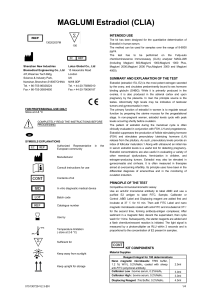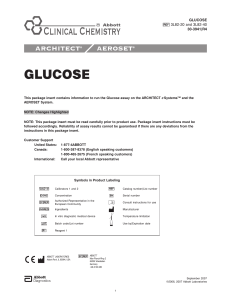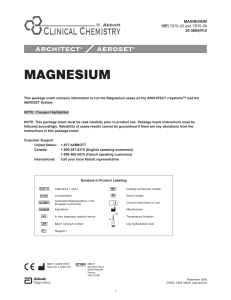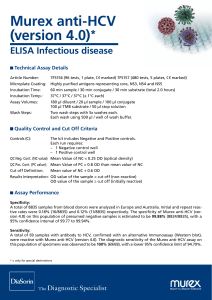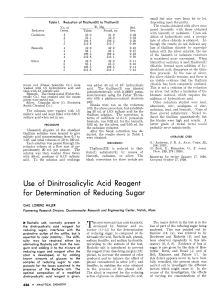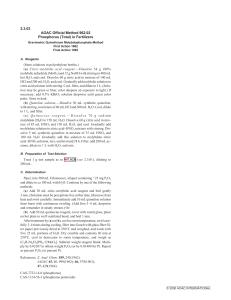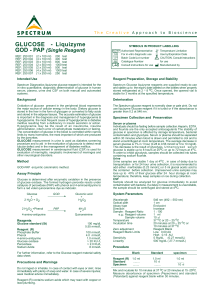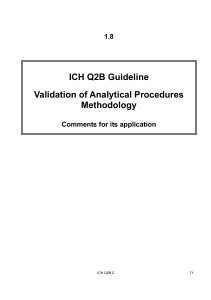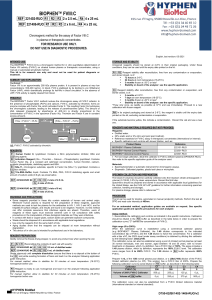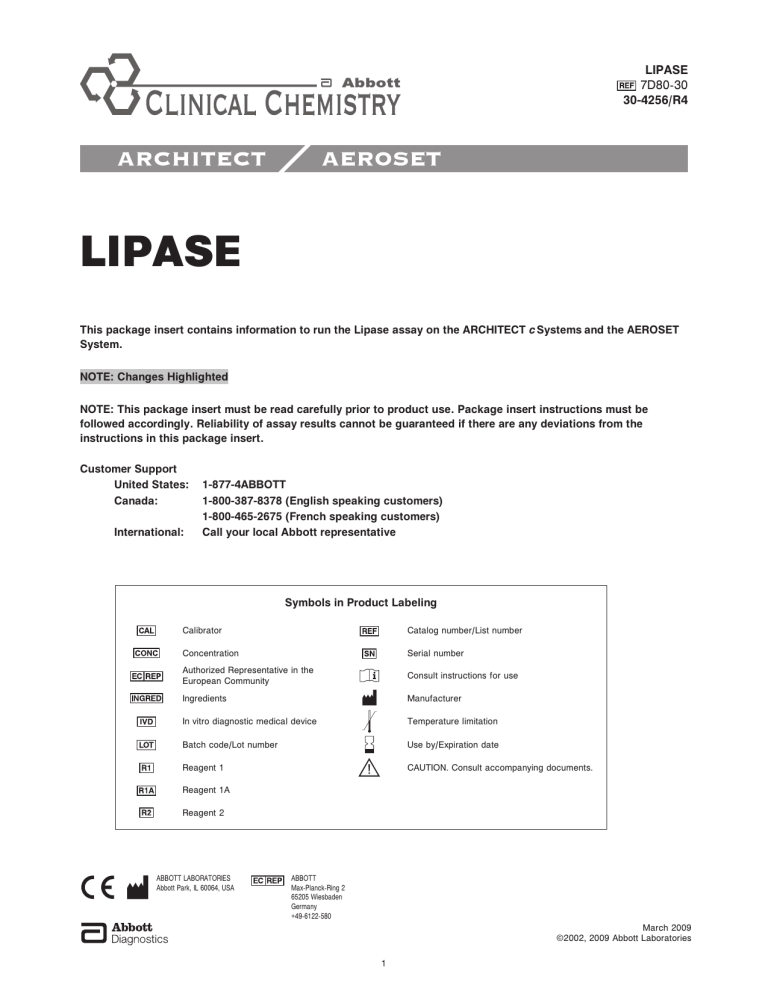
LIPASE 7D80-30 30-4256/R4 LIPASE This package insert contains information to run the Lipase assay on the ARCHITECT c Systems and the AEROSET System. NOTE: Changes Highlighted NOTE: This package insert must be read carefully prior to product use. Package insert instructions must be followed accordingly. Reliability of assay results cannot be guaranteed if there are any deviations from the instructions in this package insert. Customer Support United States: Canada: International: 1-877-4ABBOTT 1-800-387-8378 (English speaking customers) 1-800-465-2675 (French speaking customers) Call your local Abbott representative Symbols in Product Labeling Calibrator Catalog number/List number Concentration Serial number Authorized Representative in the European Community Consult instructions for use Ingredients Manufacturer In vitro diagnostic medical device Temperature limitation Batch code/Lot number Use by/Expiration date Reagent 1 CAUTION. Consult accompanying documents. Reagent 1A Reagent 2 ABBOTT LABORATORIES Abbott Park, IL 60064, USA ABBOTT Max-Planck-Ring 2 65205 Wiesbaden Germany +49-6122-580 March 2009 ©2002, 2009 Abbott Laboratories 1 NAME REAGENT HANDLING AND STORAGE (Continued) LIPASE Instructions for Use INTENDED USE 1. Prepare the Working Reagent by adding the contents of the large Lipase to the smaller Lipase . The Lipase assay is used for the quantitation of lipase in human serum or plasma. SUMMARY AND EXPLANATION OF TEST R1 Pancreatic lipase in serum and plasma is closely associated with pancreatic diseases. The activity of this enzyme has been measured as an important marker for diagnosing pancreatic diseases and the associated monitoring of therapeutic effects. Pancreatic lipase test kits currently available include a turbidimetric method using triglyceride as substrate and a colorimetric method using synthetic substrates. These methods, however: 1) lack precision near the normal level; 2) exhibit poor reproducibility; and 3) are affected by other enzymes such as esterases. The enzymatic color rate assay uses a clear substrate solution of 1,2-diglyceride, which is a ‘natural’ substrate. The assay is highly sensitive and specific for pancreatic lipase, using colipase and deoxycholate as activators. Precautions for Users 1. 2. 3. 4. 5. For in vitro diagnostic use. Do not use components beyond the expiration date. Do not mix materials from different kit lot numbers. Do not mix reagents prepared at different times. Do not reuse the reagent containers, bottles, caps, or plugs due to the risk of contamination and the potential to compromise reagent performance. 6. CAUTION: This product contains human sourced and/or potentially infectious components. Refer to the REAGENTS section of this package insert. No known test method can offer complete assurance that products derived from human sources or inactivated microorganisms will not transmit infection. Therefore, all human sourced materials should be considered potentially infectious. It is recommended that these reagents and human specimens be handled in accordance with the OSHA Standard on Bloodborne Pathogens.1 Biosafety Level 22 or other appropriate biosafety practices3,4 should be used for materials that contain or are suspected of containing infectious agents. The human serum albumin used in Reagent 1A has been tested and found to be nonreactive for HBsAg, anti-HCV, and anti-HIV-1/HIV-2. and contain sodium azide. Contact with acids liberates 7. very toxic gas. This material and its container must be disposed of in a safe way. For reagents not classified as dangerous per European Directive 1999/45/EC as amended, safety data sheet available for professional user on request. Reagent Kit 7D80 Lipase is supplied as a two-reagent kit which contains: 5 x 29 mL 5 x 30 mL Contains human serum albumin. 5 x 14 mL Estimated tests per kit: 778 Calculation is based on the minimum reagent fill volume per kit. Concentration 5.34 mmol/L 1.1 mmol/L Monoglyceride Lipase ≥ 0.86 U/mL Glycerol Kinase ≥ 1.34 U/mL Glycerol-3-Phosphate Oxidase ≥ 40.0 U/mL Peroxidase ≥ 1.34 U/mL Colipase ≥ 40.0 U/mL TOOS 0.66 mmol/L Deoxycholate 36.0 mmol/L 4-Aminoantipyrine SPECIMEN COLLECTION AND HANDLING Suitable Specimens Serum and plasma are acceptable specimens. • Serum: Use serum collected by standard venipuncture techniques into glass or plastic tubes with or without gel barriers. Ensure complete clot formation has taken place prior to centrifugation. When processing samples, separate serum from blood cells or gel according to the specimen collection tube manufacturer’s instructions. Some specimens, especially those from patients receiving anticoagulant or thrombolytic therapy, may take longer to complete their clotting processes. Fibrin clots may subsequently form in these sera and the clots could cause erroneous test results. • Plasma: Use plasma collected by standard venipuncture techniques into glass or plastic tubes. Acceptable anticoagulants are lithium heparin (with or without gel barrier) and sodium heparin. Ensure centrifugation is adequate to remove platelets. When processing samples, separate plasma from blood cells or gel according to the specimen collection tube manufacturer’s instructions. For total sample volume requirements, refer to the instrument-specific ASSAY PARAMETERS section of this package insert and Section 5 of the instrument-specific operations manual. 0.068% ATP R1 WKG WARNINGS AND PRECAUTIONS REAGENTS 1,2-Diglyceride = 2. Replace the reagent stopper and mix by gentle inversion to achieve complete dissolution. 3. Return the prepared Working Reagent to the cartridge and mix again by gentle inversion. Remove air bubbles, if present in the reagent cartridge, with a new applicator stick. 4. Place the cartridge in Reagent Supply Center 1. cartridge in Reagent Supply Center 2. 5. Place the Lipase acts on a natural substrate, 1,2-diglyceride, to liberate 2-monoglyceride. This is hydrolyzed by monoglyceride lipase into glycerol and free fatty acid. Glycerol kinase acts on glycerol to form glycerol-3-phosphate which is in turn acted on by glycerol-3-phosphate oxidase to generate hydrogen peroxide. Peroxidase converts the hydrogen peroxide, 4-aminoantipyrine, and N-ethyl-N-(2-hydroxy3-sulfopropyl)-m-toluidine (TOOS) into a quinone dye. The rate of formation of the dye, measured as an increase in absorbance at 548 nm, is proportional to the lipase concentration in the sample. Methodology: Quinone Dye Cholic Acid R1A Working Reagent 1 PRINCIPLES OF PROCEDURE Reactive Ingredients + 0.12% REAGENT HANDLING AND STORAGE Reagent Handling Remove air bubbles, if present in the reagent cartridge, with a new applicator stick. Alternatively, allow the reagent to sit at the appropriate storage temperature to allow the bubbles to dissipate. To minimize volume depletion, do not use a transfer pipette to remove the bubbles. CAUTION: Reagent bubbles may interfere with proper detection of reagent level in the cartridge, causing insufficient reagent aspiration which could impact results. Reagent Storage Unopened reagents are stable until the expiration date when stored at 2 to 8°C. Reagent stability is 11 days if the reagent is uncapped and onboard. 2 SPECIMEN COLLECTION AND HANDLING (Continued) QUALITY CONTROL Specimen Storage The following is the recommendation of Abbott Laboratories for quality control. As appropriate, refer to your laboratory standard operating procedure(s) and/or quality assurance plan for additional quality control requirements and potential corrective actions. • Two levels of controls (normal and abnormal) are to be run every 24 hours. • If more frequent control monitoring is required, follow the established quality control procedures for your laboratory. • If quality control results do not meet the acceptance criteria defined by your laboratory, patient values may be suspect. Follow the established quality control procedures for your laboratory. Recalibration may be necessary. • Review quality control results and acceptance criteria following a change of reagent or calibrator lot. Serum/Plasma Temperature Maximum Storage Bibliographic Reference 20 to 25°C 7 days 5 2 to 8°C 7 days 5, 6 -20°C 1 year 5 Guder et al.5 suggest storage of frozen specimens at -20°C for no longer than the time interval cited above. However, limitations of laboratory equipment make it necessary in practice for clinical laboratories to establish a range around -20°C for specimen storage. This temperature range may be established from either the freezer manufacturer’s specifications or your laboratory standard operating procedure(s) for specimen storage. NOTE: Stored specimens must be inspected for particulates. If present, mix and centrifuge the specimen to remove particulates prior to testing. RESULTS Refer to the instrument-specific operations manual for information on results calculations. • ARCHITECT System Operations Manual—Appendix C • AEROSET System Operations Manual—Appendix A Representative performance data are given in the EXPECTED VALUES and SPECIFIC PERFORMANCE CHARACTERISTICS sections of this package insert. Results obtained in individual laboratories may vary. PROCEDURE Materials Provided 7D80 Lipase Reagent Kit Materials Required but not Provided LIMITATIONS OF THE PROCEDURE • 3E16 Lipase Calibrator, 2 x 3 mL • Control Material • Saline (0.85% to 0.90% NaCl) for specimens that require dilution • 2J94 Detergent B for ARCHITECT c Systems only Refer to the SPECIMEN COLLECTION AND HANDLING and PERFORMANCE CHARACTERISTICS sections of this package insert. For the ARCHITECT c Systems only: Detergent B solution must be onboard the system. For the AEROSET System only: Lipase must be run on a separate line from Calcium, Cholesterol, Carbon Dioxide, MULTIGENT Direct LDL, Triglyceride, and Uric Acid. Refer to Section 2 of the AEROSET System Operations Manual for additional information. Assay Procedure For a detailed description of how to run an assay, refer to Section 5 of the instrument-specific operations manual. Specimen Dilution Procedures EXPECTED VALUES The ARCHITECT c Systems and the AEROSET System have automatic dilution features; refer to Section 2 of the instrument-specific operations manual for additional information. Serum and plasma: Specimens with lipase values exceeding 1,200 U/L are flagged and may be diluted using the Automated Dilution Protocol or the Manual Dilution Procedure. Reference Range Serum7 Range (U/L) Adult Automated Dilution Protocol If using the Automated Dilution Protocol, the system performs a dilution of the specimen and automatically corrects the enzyme activity value by multiplying the result by the appropriate dilution factor. To set up the automatic dilution feature, refer to Section 2 of the instrument-specific operations manual for additional information. 8 to 78 A study was conducted using 133 serum samples from volunteers. Data were analyzed as described by Clinical and Laboratory Standards Institute (CLSI) protocol NCCLS C28-A.8 From this study, 95% of all specimens fell within 8 to 78 U/L, with samples ranging from 7 to 90 U/L. It is recommended that each laboratory determine its own reference range based upon its particular locale and population characteristics. Manual Dilution Procedure Manual dilutions should be performed as follows: • Use saline (0.85% to 0.90% NaCl) to dilute the sample. • The operator must enter the dilution factor in the patient or control order screen. The system uses this dilution factor to automatically correct the enzyme activity value by multiplying the result by the entered factor. • If the operator does not enter the dilution factor, the result must be multiplied by the appropriate dilution factor before reporting the result. NOTE: If a diluted sample result is flagged indicating it is less than the linear low limit, do not report the result. Rerun using an appropriate dilution. For detailed information on ordering dilutions, refer to Section 5 of the instrument-specific operations manual. SPECIFIC PERFORMANCE CHARACTERISTICS Linearity Lipase is linear up to 1,200 U/L. Linearity was verified using CLSI protocol NCCLS EP6-P.9 Limit of Detection (LOD) The LOD for Lipase is 1.6 U/L. The LOD is the mean concentration of an analyte-free sample + 2 SD, where SD = the pooled, within-run standard deviation of the analyte-free sample. Limit of Quantitation (LOQ) The LOQ for Lipase is 3.1 U/L. The LOQ is the analyte concentration at which the CV = 20%. CALIBRATION Calibration is stable for approximately 11 days (264 hours) and is required with each change in reagent lot number. Verify calibration with at least two levels of controls according to the established quality control requirements for your laboratory. If control results fall outside acceptable ranges, recalibration may be necessary. For a detailed description of how to calibrate an assay, refer to Section 6 of the instrument-specific operations manual. For information on calibrator standardization, refer to the Lipase Calibrator package insert. 3 SPECIFIC PERFORMANCE CHARACTERISTICS (Continued) BIBLIOGRAPHY 1. US Department of Labor, Occupational Safety and Health Administration. 29 CFR Part 1910.1030, Bloodborne Pathogens. 2. US Department of Health and Human Services. Biosafety in Microbiological and Biomedical Laboratories, 5th ed. Washington, DC: US Government Printing Office, January 2007. 3. World Health Organization. Laboratory Biosafety Manual, 3rd ed. Geneva: World Health Organization, 2004. 4. Sewell DL, Bove KE, Callihan DR, et al. Protection of Laboratory Workers from Occupationally Acquired Infections; Approved Guideline—Third Edition (M29-A3). Wayne, PA: Clinical and Laboratory Standards Institute, 2005. 5. Guder WG, da Fonseca-Wollheim F, Heil W, et al. The Quality of Diagnostic Samples. Darmstadt, Germany: GIT Verlag; 2001:36–7. 6. US Pharmacopeial Convention, Inc. General notices. In: US Pharmacopeia National Formulary, 1995 ed (USP 23/NF 18). Rockville, MD: The US Pharmacopeial Convention, Inc; 1994:11. 7. Data on file at Abbott Laboratories. 8. Sasse EA, Aziz KJ, Harris EK, et al. How to Define and Determine Reference Intervals in the Clinical Laboratory; Approved Guideline (C28-A). Villanova, PA: The National Committee for Clinical Laboratory Standards, 1995. 9. Passey RB, Bee DE, Caffo A, et al. Evaluation of the Linearity of Quantitative Analytical Methods; Proposed Guideline (EP6-P). Villanova, PA: The National Committee for Clinical Laboratory Standards, 1986. 10. Powers DM, Boyd JC, Glick MR, et al. Interference Testing in Clinical Chemistry; Proposed Guideline (EP7-P). Villanova, PA: The National Committee for Clinical Laboratory Standards, 1986. 11. Young DS. Effects of Drugs on Clinical Laboratory Tests, 4th ed. Washington, DC: AACC Press; 1995:3-398–3-400. 12. Kennedy JW, Carey RN, Coolen RB, et al. Evaluation of Precision Performance of Clinical Chemistry Devices—Second Edition; Tentative Guideline (EP5-T2). Villanova, PA: The National Committee for Clinical Laboratory Standards, 1992. 13. Kennedy JW, Carey RN, Coolen RB, et al. Method Comparison and Bias Estimation Using Patient Samples; Approved Guideline (EP9-A). Wayne, PA: The National Committee for Clinical Laboratory Standards, 1995. Interfering Substances Interference studies were conducted using CLSI protocol NCCLS EP7-P.10 Interference effects were assessed by Dose Response and Paired Difference methods, at the medical decision level of the analyte. Interfering Substance Bilirubin Hemoglobin Intralipid Interferent Concentration N Target Observed (U/L) (% of Target) 15 mg/dL (257 μmol/L) 4 212.3 30 mg/dL (513 μmol/L) 4 212.3 86.4 4 215.7 103.1 1,000 mg/dL (10.0 g/L) 94.7 2,000 mg/dL (20.0 g/L) 4 215.7 99.1 750 mg/dL (7.5 g/L) 4 198.1 94.1 1,000 mg/dL (10.0 g/L) 4 198.1 93.9 Bilirubin solutions at the above concentrations were prepared by addition of a bilirubin stock to human serum pools. Hemoglobin solutions at the above concentrations were prepared by addition of hemolysate to human serum pools. Intralipid solutions at the above concentrations were prepared by addition of Intralipid to human serum pools. Interferences from medications or endogenous substances may affect results.11 Precision The imprecision of the Lipase assay is ≤ 7.5% Total CV. Representative data from studies using CLSI protocol NCCLS EP5-T212 are summarized below. Control Level 1 N 80 80 Mean (U/L) 42.7 78.6 1.43 Within Run Between Run Level 2 SD 0.31 %CV 0.7 1.8 SD 1.13 1.88 %CV 2.6 2.4 SD 0.91 2.62 %CV 2.1 3.3 SD 1.48 3.53 %CV 3.5 4.5 TRADEMARKS The ARCHITECT c System family of instruments consists of c 4000, c 8000, and c 16000 instruments. AEROSET, ARCHITECT, c 4000, c 8000, c 16000, c System, MULTIGENT, and SmartWash are trademarks of Abbott Laboratories. All other trademarks, brands, product names, and trade names are the property of their respective companies. Between Day Total Method Comparison Correlation studies were performed using CLSI protocol NCCLS EP9-A.13 Serum results from the Lipase assay on the AEROSET System were compared with those from a commercially available enzymatic methodology. Serum results from the Lipase assay on an ARCHITECT c System were compared with the Lipase assay on the AEROSET System. N AEROSET vs. Comparative Method 74 ARCHITECT vs. AEROSET 80 Y - Intercept -1.458 2.891 Correlation Coefficient 1.000 0.997 0.936 10.3 to 619.1 1.032 3.10 to 1,146.80 Slope Range (U/L)* *AEROSET 4 ARCHITECT c SYSTEMS ASSAY PARAMETERS Lipase Serum/Plasma—Conventional and SI Units Configure assay parameters — General ● General Configure assay parameters — SmartWash о Calibration о SmartWash о Results о Interpretation о General о Calibration ● SmartWash о Results о Interpretation Assay: Lip COMPONENT REAGENT / ASSAY WASH Volume Replicates R1 ACETM 0.5% AcidWash 345 1* R1 LIP00 10% Detergent B 345 2 R1 All 10% Detergent B 345 2 R2 LIP00 10% Detergent B 345 2 R2 All 10% Detergent B 345 2 Cuvette CO2 10% Detergent B 345 Cuvette Uric 10% Detergent B 345 Cuvette Trig 10% Detergent B 345 Cuvette Chol 10% Detergent B 345 Cuvette Uric-U 10% Detergent B 345 Sample Probe 0.5% AcidWash *Reagent Probe SmartWashes must be configured in order listed. Assay: Lip Type: Photometric Version: † Number: 1029 ● Reaction definition о Reagent / Sample о Validity checks Reaction mode: Rate up Primary Secondary Read times Wavelength: 548 / 660 Main: 22 – 33 Last required read: 33 Flex: ___–___ Absorbance range: ___–___ Color Correction: ___–___ Sample blank type: None о Reaction definition ● Reagent / Sample Reagent: LIP00 Diluent: Saline Diluent dispense mode: Type 0 Diluted Dilution name Sample sample STANDARD : 4.0 ___ _________ : ___ ___ _________ : ___ ___ о Reaction definition Reaction check: о Validity checks Reagent volume: Water volume: Dispense mode: Diluent ___ ___ ___ R1 156 ___ Type 0 Water Dilution factor ___ = 1:1.00 ___ = ___ = о Reagent / Sample End Subtraction R2 52 ___ Type 0 Default dilution Configure assay parameters — Results о General о SmartWash ● Results о Interpretation Assay: Lip Assay number: 1029 Dilution default range: Result units: U/L Low-Linearity: 4†† High-Linearity: 1200 Gender and age specific ranges: GENDER AGE (UNITS) NORMAL EXTREME Either 0 – 130 (Y) 8 – 78 ● о о ● Validity checks A B Read Time: 33 – 33 31 – 31 Calculation limits: 0.0001 – 9.9999 Rate linearity %: ___ Configure result units Assay: Version: Result units: Decimal places: Correlation factor: Intercept: Configure assay parameters — Calibration о General Assay: ● Calibration о SmartWash о Results Lip Replicates: 3 о Volumes о Intervals Calibrator level: Blank: Water Cal 1: Lipase1 ● Volumes о Intervals Calibrator: Lipase Calibrator level Water Lipase1 о Calibrators о Volumes Calibration intervals: Full interval: 264 Calibration type: Adjust type: None о Calibrators о Validity checks Lip † U/L 0 [Range 0 – 4] 1.0000 0.0000 Concentration: 0 ‡ [Range 1 – 3] о Calibrators Blank: Cal 1: о Interpretation Calibration method: Linear ● Calibrators Calibrator set: Lipase о Calibration о Volumes Blank absorbance range: Span: Span absorbance range: Expected cal factor: Expected cal factor tolerance %: Sample 4.0 4.0 Diluted sample ___ ___ ● Intervals о Validity checks Diluent ___ ___ Water ___ ___ о Validity checks (hours) о Intervals _____ – _____ Blank – Blank _____ – _____ 0.00 0 ● Validity checks † Due to differences in instrument systems and unit configurations, version numbers may vary. †† The linear low value (Low-Linearity) is LOQ rounded up to the number of decimal places defined in the decimal places parameter field. ‡ Refer to concentration specified on calibrator labeling or value sheet. In ARCHITECT software version 5.00 and above, these values are defined on the Configure calibrator set screen. 5 AEROSET SYSTEM ASSAY PARAMETERS Lipase Serum/Plasma—Conventional and SI Units Assay Configuration: Outline Page Assay Name Assay # Lip 29 Quantitative Ranges Min Text Min Panic-L * 0.0* 0.0 4** Reference Ranges* Age Line A-Line L-Reference-H 8 78 L-Linear Range-H 0.0 0.0 0.0 0.0 0 Year 0 Year 0 Year Qualitative Ranges Male – – – – 0.0 0.0 0.0 0.0 Panic-H 0.0 1200 0.0 0.0 0.0 0.0 Max 0.0* Max Text * Female – 0.0 – 0.0 – 0.0 – 0.0 N/A Assay Configuration: Base Page Reaction Mode Wavelength-Prim/Sec Read time-Main/Flex Linearity% RATE UP 548 / 660 22 – 33 / 0 – 0 0 Sample Blank Test Blank Read Time Abs Window Abs Limits _____ ( ___ ) 0–0 0–0 0.0 – 0.0 S.Vol DS.Vol D.Vol W.Vol Standard 4.0 0.0 0 0 Rgt Name/Pos Dil 1 4.0 0.0 0 0 Diluent: _____ _–__* Dil 2 4.0 0.0 0 0 Type# 0 Rgt Name/Pos R.Vol W.Vol Type# Reagent 1 LIP0051 – ___* 156 0 0 Reagent 2 LIP0052 – ___* 52 0 0 Reaction Check Read Time – A/B Range Minimum END SUB 33 – 33 / 31 – 31 0.0001 – 9.9999 0.0 Factor/Intercept Decimal Places Units 1.0 / 0.0 0 U/L Assay Configuration: Calibration Page Calib Mode Linear Blank/Calib Replicates 3/3 Sample S.Vol BLK Water 4.0 C1 Lipase 4.0 C2 2.0 Extrapolation% 0 DS.Vol D.Vol 0.0 0 0.0 0 0.0 0 Interval (H) 264 Span Span Abs Range BLK – 1 0.0 – 0.0 W.Vol BLK Abs Range 0 0.0 – 0.0 0 Cal Deviation 0 0.0 FAC Limit (%) 10 Assay Configuration: SmartWash Page Rgt Probe Reagent*** LIP0051 LIP0052 CK00051† CK00042†† UHDL061 ACETM41 ACETM42 DIG0051 DIG0012 AMIK941 AMIK942 VANCO51 VANCO52 TOBRA41 TOBRA42 DGTOB11 DGTOB12 Wash AlkW AlkW Water Water AlkW AcidW AcidW AlkW AlkW AlkW AlkW AlkW AlkW AlkW AlkW AlkW AlkW Vol 300 300 345 345 345 345 345 345 345 345 345 345 345 345 345 345 345 Cuvette Assay Name — Wash — Vol — Sample Probe Wash — Refer to Assay Configuration in Section 2 of the AEROSET System Operations Manual for information regarding assay parameters. * User defined or instrument defined. ** The linear low value (L-Linear Range) is LOQ rounded up to the number of decimal places defined in the decimal places parameter field. *** Rgt Probe SmartWashes must be implemented if the Lipase assay is configured on the same line as the donor assay. AEROSET software allows configuration of only 16 Reagent Probe washes per assay. † Reagent SmartWash listed is for CK 7D63-21. For CK 7D63-20 or 7D63-30, change this Reagent SmartWash to CK00061. †† Reagent SmartWash listed is for CK 7D63-21. For CK 7D63-20 or 7D63-30, change this Reagent SmartWash to CK00052. 6 7 8
